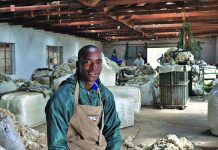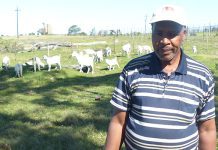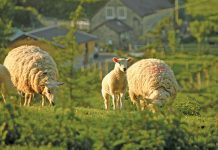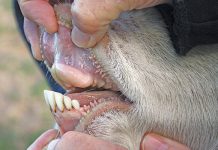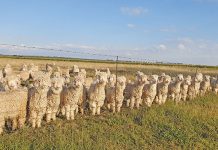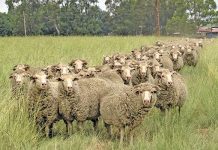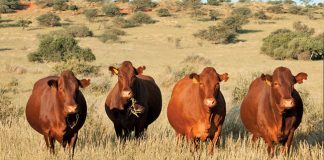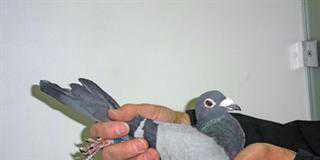By mid-February, SA will have five indigenous goat breeds. The Indigenous Veld Goat will soon be officially registered as a breed and a breeders’ society established – two milestone events for local animal husbandry. Chris Nel outlines the characteristics of this exceptional breed and aspects pertaining to breed administration. Pliny the Elder, the Roman commentator on Africa, once exclaimed, “Ex Afrika semper aliquid novum!” (“Out of there is always something new!”).
The Veld Goat is an age-old African genotype. What is new, however, is its imminent registration as a breed in terms of the Animal Improvement Act, which will formalise and add to its status.
Also imminent is the foundation meeting of a breeders’ society on 16 February in Bloemfontein, and the first sale of selected breeding stock the following day. he book Landrace Breeds: South Africa’s Indigenous and Locally Developed Farm Animals lists three indigenous cattle breeds, six sheep breeds, four goat breeds, three chicken breeds and one pig breed.
Then there are four locally developed cattle breeds, seven sheep breeds, one chicken breed, three horse breeds as well as an ostrich and a camel breed. The four indigenous goats described in the book are the Improved Boer Goat, the Kalahari Red Goat, the Savannah Goat and the Unimproved Veld Goat. Now, with the Indigenous Veld Goat, there will be five. Characteristics Contrasting with the situation in the improved breeds, man has had almost no input in the evolution of the Indigenous Veld Goat.
Nature has selected it for functional efficiency, and breeders agree it must stay that way. he breed is superbly adapted to harsh environments all over Southern Africa and is exceptionally tick, parasite and disease tolerant. The length and nature of the hair coat depends on the climate. Some goats have a fine undercoat for extra protection in winter. The Indigenous Veld Goat has longer legs resembling those of antelope, strong flock instincts, and forages effortlessly over extensive areas. Colouration varies from solid colour to multi-coloured patterns. Spotted and heterogeneous colour patterns are claimed to be difficult for predators to see. darkly pigmented skin is highly heat and sun tolerant.
The hard brown hooves rarely show signs of claw development. Horns grow wild or upright in many different shapes and sizes. Naturally polled goats occasionally occur. Variation in ear form, but excluding milk goat shaped ears, is permissible. R ams are masculine with prominent neck and shoulder hair. The face is straight and reasonably wide between the eyes. Testes are well formed, equal in size and carried near the body. Ewes are feminine with long necks and well-developed udders with functional teats and plenty of milk. Udders should not droop. breed is known for its excellent fertility, non-seasonal breeding cycle, and outstanding maternal qualities.
Breed administration he constitution provides for the affairs of the society to be managed by a council of three members elected by the members of the society present at the annual general meeting. Holding office for three years, they are eligible for re-election. The council determines where the society’s office is situated. he society promotes the breeding of the Indigenous Veld Goat, and the improvement of its genetic production potential. It lays down minimum standards for approval of animals, and appoints inspectors to evaluate all goats submitted for registrafarmer’s tion.
Breed standards are based on fertility, hardiness and visual appraisal for lack of genetic defects. Confirmation is related to functional efficiency without affecting the inherent traits. To maintain breed standards and integrity, all animals offered at sales held under the society’s auspices are screened beforehand. The society also recommends or refuses applications to import and export animals, semen and embryos. Taking inspiration from economically orientated cattle breeds such as the Bonsmara, Nguni and Beefmaster, only non-competitive exhibition at agricultural shows is allowed, also giving upcoming breeders a chance to participate. This is in contrast to competition showing, which tacitly encourages breeders to feed animals unnaturally, which can harm the breed.
Every breeder registers an exclusive prefix and a herd designation mark with the society to identify all animals as stipulated by legislation. Identification for breeding records is optional – the society can provide this information if required. A society-designed emblem is tattooed in the ear of each approved Indigenous Veld Goat.
Sources: Keith Ramsay, Liz Harris and Antoinette Kotze (undated). Landrace Breeds: South Africa’s Indigenous and Locally Developed Farm Animals. Pretoria, Farm Animal Conservation Trust, ISBN 0-620-25493-9. Quentin Campbell (1995). The Indigenous sheep and goat breeds of South Africa. Published by QP Campbell, 4 Dersley Street, BAYSWATER 9301, Bloemfontein. 44pp. Contact Schalk van der Walt on (051) 654 0150/0302 or e-mail [email protected]. |fw
Indigenous goats – a genetic treasure trove
Archaeological evidence suggests the domesticated goat is descended from a species of wild mountain goat in Armenia on the Aegean Sea, and was probably domesticated in Mesopotamia around 7 000BC. By 5 000BC it had spread to Syria and from there gradually westwards and southwards from Egypt. It eventually arrived in Southern Africa with migrating tribes during the Iron Age. “Indigenous goat” is a collective term describing all varieties of native SA goat breeds.
Specific varieties are usually named according to the geographical areas in which they occur, or the nations or tribes associated with them. According to Dr Quentin Campbell, a world-renowned authority on SA smallstock, the indigenous goats of SA can be classed into four main categories: Speckled goats (Skilderbokke), Loskop South indigenous goats, KwaZulu-Natal Nguni goats and Delftzijl goats. However, this classification does not accommodate the thousands of indigenous goats found outside these specific locations throughout the country, all well adapted to their respective environments that have influenced their specific characteristics and husbandry practices.
Although highly specialised breeds do exist, most goats are dual or multi-purpose, and village flocks are often of mixed type. Meat, milk, hair and skins are economically valuable products to their owners. The indigenous goats in SA vary in terms of horn and coat type, colour, ear length and size. They are mostly medium-sized, with environmental extremes being mainly responsible for the size and type variation. But then, different types can be found in the same region and even within the same flock. It is from this heterogeneous gene pool that the Indigenous Veld Goat is being developed through natural selection. An example is Schalk van der Walt, a breeder from Venterstad in the Eastern Cape, who built up his goat flock over eight years from breeding stock from the Kaokoveld and Kunene (Namibia), the former Ciskei and Transkei as well as Duiwelskloof in Limpopo.
Some of his animals are descended from goats of the Dorslandtrekkers who trekked from Sutherland to Namibia. Indigenous goats vary greatly in colour and size. The original goats of Southern Africa probably resembled the Skilderbokke of the Kavango, described by the missionary John Barrow in 1801 as “small, handsome goats speckled like a leopard”. Skilderbokke from the Hart River were used as a basis for the Improved Boer Goat, but the pure Skilderbok population dropped dramatically afterwards and almost became extinct. A long-haired variety is today mainly confined to KZN. The skin is of a high quality and the fine underfur can be combed out to produce cashmere.
Long-haired goats can have short-haired parents and offspring. Another genotype presently being protected is the Shangaan goat, kept in the Tsonga Kraal near Eiland. The Cilliers family of Douglas, Northern Cape developed the original Savanna out of indigenous African goats when Mrs Cilliers’s Griqua workers gave her a white goat, reportedly a ram. She acquired a further five goats with white in their colour pattern and used this foundation herd to develop a white breeding line. This herd is now kept in a camp near the Vaal River under extremely marginal conditions. More recently, three other herds were established in different parts of the country to meet the demand for white goats for ceremonial purposes. Savannah Goats are fertile, heat tolerant and parasite resistant and, while their hair is white, their black skins protect them from strong solar radiation.
The Boer goat originated from indigenous African goats when early settlers started crossbreeding them with imported Indian goats in 1661. The Improved Goat, the only true meat goat breed in the world, was developed from several distinct ancestral Boer goat types: the Briekwa (brindled), Jas, Polled, Red-headed, Rona and Short-eared, through directed selection over 300 years that produced a much larger animal. Although coarse-grained, its meat is tender and palatable. In some areas the Boer goat is an important milk producer.
The Kalahari Red is a relatively recent addition to the list of registered goat breeds. It was developed by selective breeding from red-coloured, lop-eared indigenous goats, as well as red-coloured Boer goats and Savanna Goats. As the progeny began to show uniformity, it was registered as a landrace breed in 1998.

